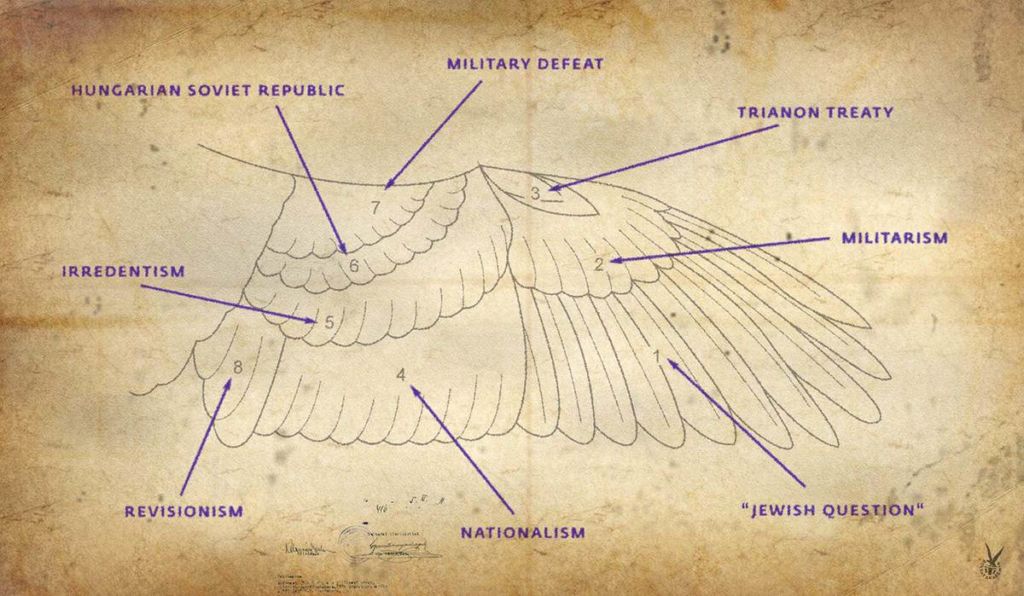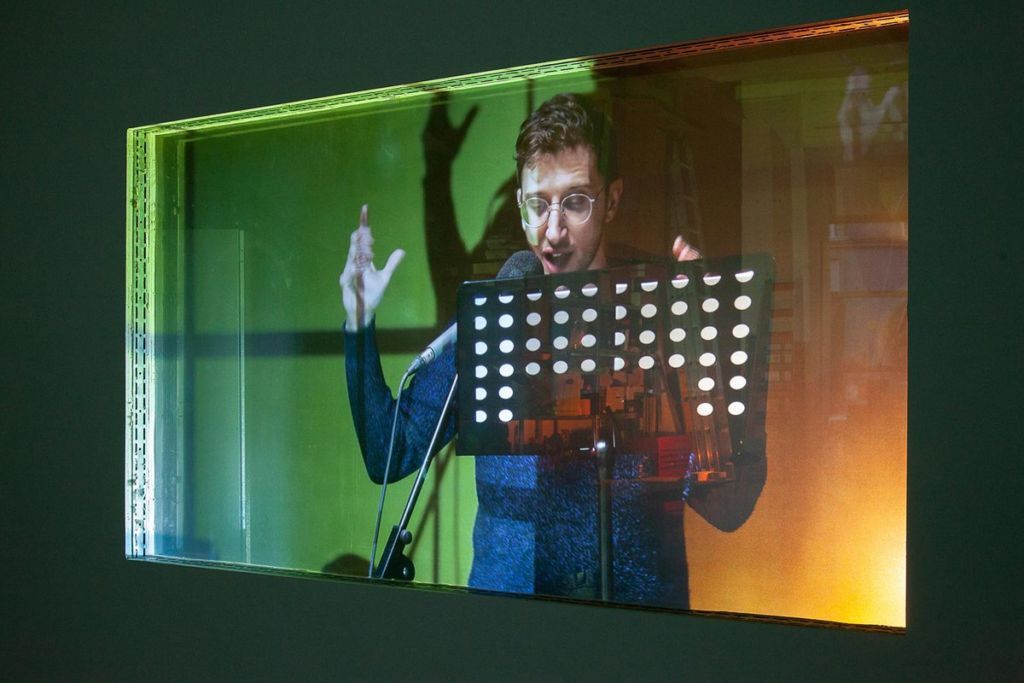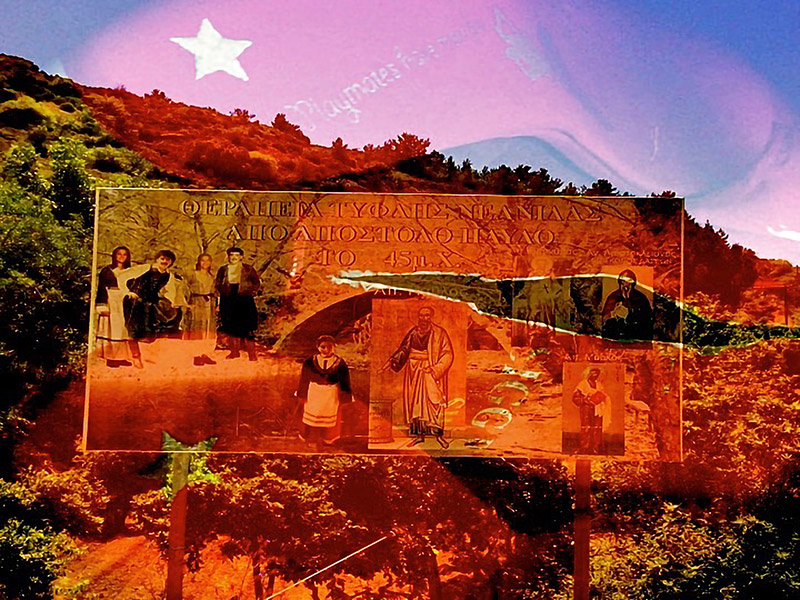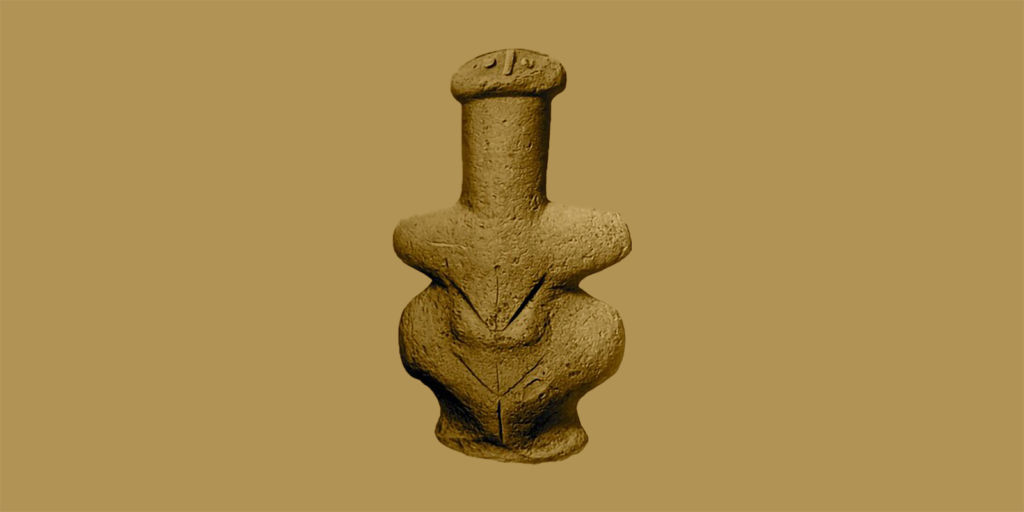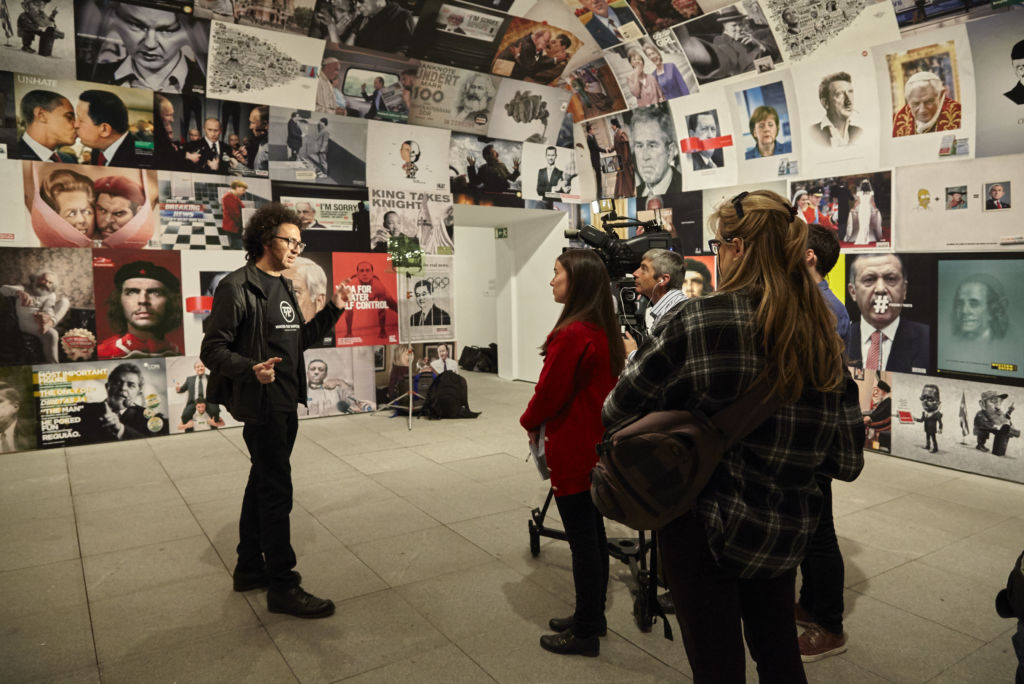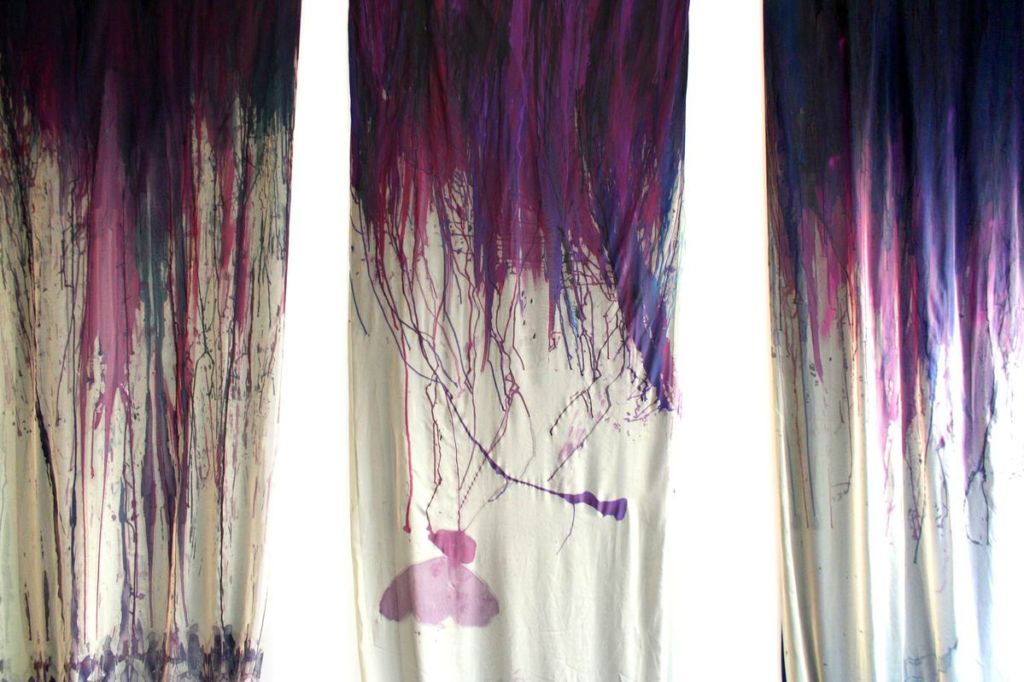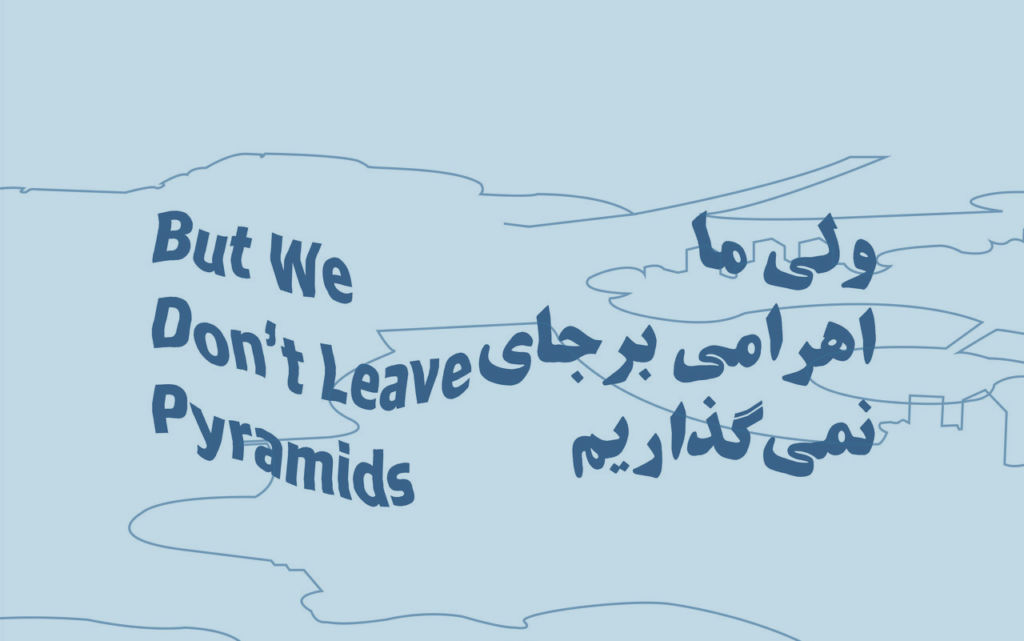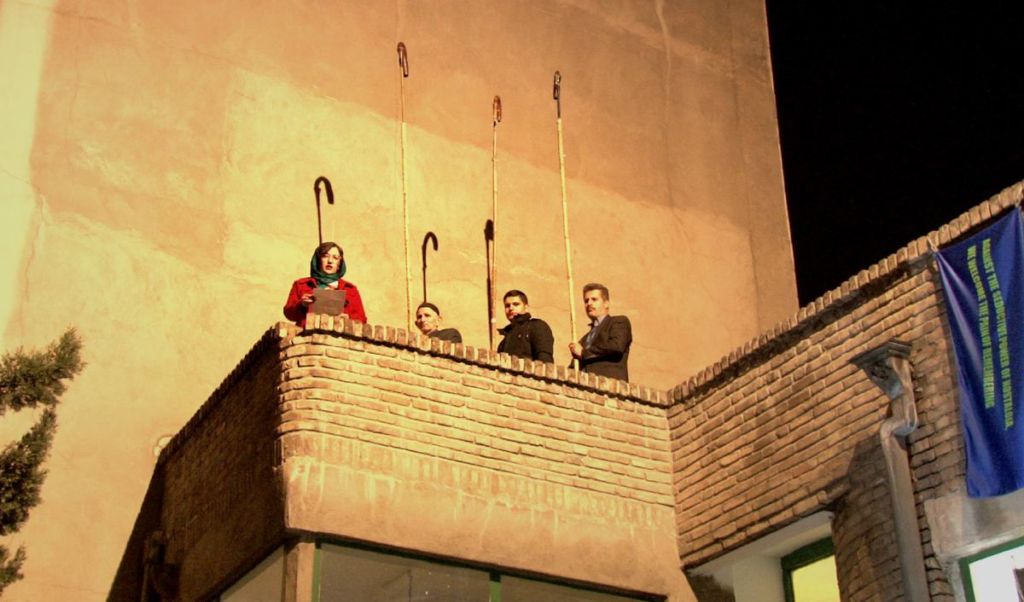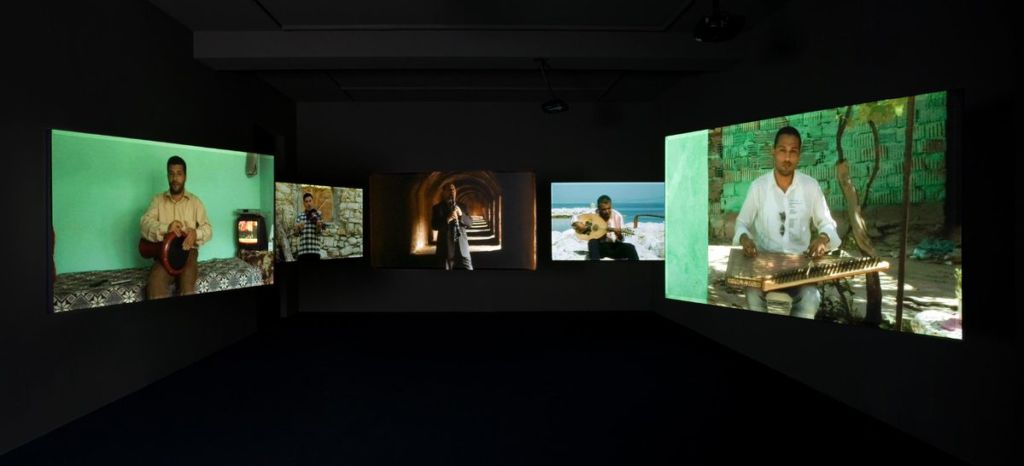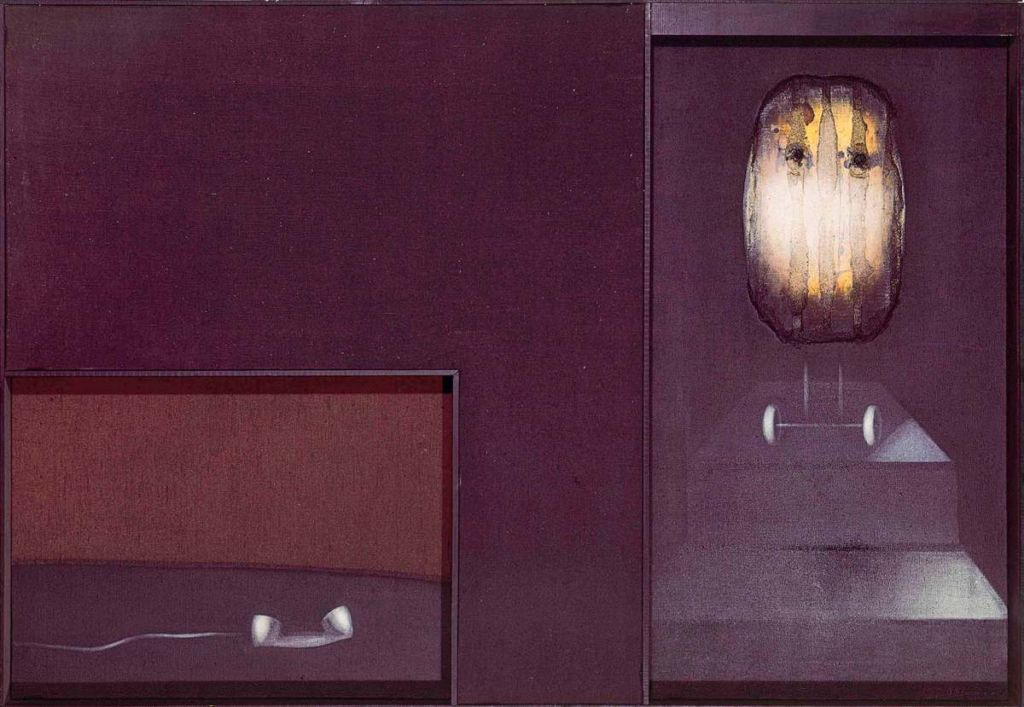This thing is addictive, you should know. Recaps of the episodes so far:
An astronomical observatory on a mountain in the Canary Islands, the sky as blue as blue can be, in the distance a sea, also quite blue. The observatory is closed, but we, we observe it.
Elsewhere, but not later in time, nobody is doing laundry in Bordeaux.
The weather is gloomy on the Liguria coast. A speedboat races toward us, cutting a white groove through the waves, a building in the foreground is being refurbished. Altogether it looks nothing like the view of Nagoya in Japan, not at all.
Suddenly, at the same instant, an automated machine stacks cabinets full of books along a deep metallic trench, its orthonormal yellow limbs dive and slide, in and out. The scene is supposedly taking place in the library archives of the University of Michigan, one of those states united under the Star-Spangled Banner.
It seems to have little effect on the small doggies at the kennel, waiting for their masters, little old grannies who have left them this afternoon so they can go to the hair salon in peace, without having to constantly shout: “No butt-sniffing! Youki, leave that butt alone!”
Elsewhere, again, it is nighttime. I get the feeling it is often night, and still the small train cannot leave, surrounded as it is by machines that seem, at the very best, recently wedded—or maybe just a decoration.
It is snowing in various places. This occurs for meteorological reasons, and sometimes also for static ones.
Editor’s note: La Vache qui Rit (The Laughing Cow) wears an earring that is a box with its own image repeated over an over in a mirror effect that borders on dairy psychedelics.
There Is A Light That Never Goes Out, The Smiths (Morrissey/J.Marr), The Queen Is Dead, LP (Rough Trade), 1986.
And so the great film of reality drifts on, promising to capture, highlight and amplify the website Acoustic Cameras. If, for example, you find yourself in a melancholic state of mind and stuck inside of Mobile (where the sun is shining, the waters of the Gulf of Mexico make gentle waves and the palm trees seem frozen in place), in one click you can travel to Memphis (where something is always going on). It is possible and is only a sliver of what else is possible.
And while we explain these things, other scenes pass by.
In Norway people are getting ready to prepare the Telemark season. Some are uncluttering the hallway of some dead branches that would otherwise stick to your pants. A six-wheel ATV hauling huge reels of cable drives up. Will everything be ready before it starts to snow? Will it snow? And if so, for how long? Oh shoot, while writing those lines, I missed ATV. It has already driven off-screen.
In Osaka too, nobody is doing laundry.
There are also test patterns, blue screens and informative texts scrolling from right to left, screens that offer myriad split screens compiled into a vertiginous mirror-effect of the surveillance process. Looks like those little devils remembered their Laughing Cow1 lessons. If, as William S. Burroughs once thought, the simultaneous accumulation of images of the present can unleash divinatory powers and represent, or who knows, even interpret the “hyper-now”, a window into the future, what should we think about those people who see, in the exponential multiplication of processed creamy cheese, the fate of cheese as we know it? But maybe I’ve said too much. Lately I’ve started to feel like somebody’s watching me.
Firefighters in San Francisco definitely have the best view, from the ceiling of their station, of the oldest working filament bulb in the world, just as we do, but with a bigger zoom onto this thumb-nosing at planned obsolescence and unintentional allegory for one of The Smith’s prettiest songs—a group2, by the way, that was not asked to participate in this project, since it is reserved strictly to artists who are still alive.
Did I mention that all these cinematic shots of the extremely real have been specifically set to music by a multitude of cutting-edge musicians and sound artists? What was I thinking? That’s what makes the whole thing so poetic: the fictional wash poured out by our speakers over the screens, set to the hi-jacked streams of webcams networked throughout our planetary territory.
There is a lot of waiting. Often we are filmed while waiting and sometimes, people far away watch us wait or, like us, just watch the ficus and yucca grow. Be it waiting for a cut and a shave in London or waiting for laundry to finally be clean and dry in Taule, it makes little difference.
Look, someone is doing laundry in Taule!
Some people also work, a bit, here and there. A little bit at a printing press in Dortmund, a little bit in a metal factory in Bucharest. Do we keep the workers under surveillance to discourage them from working on side-projects, or are the cameras just there to prove that somebody, somewhere, is working?
Often Japan or Iceland is chosen. Am I supposed to read the over-representation of these two islands as reflecting the artist’s longing for countries that are financially inaccessible, or a nostalgia for studying abroad on the taxpayer’s dime? A question that doesn’t seem to concern the lanterns gently bobbing up and down in Shibukawa, or the tide as it rises on a jetty in Reykjavik.
There are fixed frames of giant pendulums that are anything but fixed. One might think that watching them over prolonged periods of time might lead to the ultimate hypnotic experience in re-broadcasted images, but no. When it comes to saturating the mind and body, I prefer the classics: frontal shots of altars in various chapels, churches and cathedrals where nothing really happens. Maybe an old lady will move, or a candelabrum will fall over? No, nothing, ever, aside from Sunday morning, of course, but then I’m no longer in front of my screen, I’m at church. Apparently one time, during the week, there was a funeral, but I stupidly missed it, probably I was distracted by something in the here and now and not busy looking elsewhere.
Credits: Inspired by an original concept by Christophe Demarthe, created by Optical Sound (Pierre Beloüin & P. Nicolas Ledoux) and la manufacture des Cactées (Didier Hochart & Thierry Weyd), graphic design by ABM Studio, development by Didier Hochart.
But it’s not over, not yet, or were those just the opening credits following a prologue that went on for too long? It happens.
Nature, when poorly filmed, is even more boring than in real life.
On some crude plastic cubes in primary colors, dogs await their masters inside a gated yard, barking in silence as absolutely no vans drive past, at least not in Glennwood Springs, Blåvands Huk, La Laguna, Saint-Malo, Bordeaux, or even Bologna; not in Cologne, Bucharest, Rome, Tsukumi, Saint-Petersburg, Palmares; not in Taipei or Syracuse, not in Miami, Amot, Tucson, or Hamburg, not in Kijiang, Orlando, Moscow or Reykjavik, not in Tokyo or Osaka, Osnabruck or Diement; not in Seoul, Louisville, Herndon, Basslake, Indianapolis, Livermore, Boston, nor in London; not in Marans, Almere Stad, Devils Lake, Meudon, Nuuk, Almeria; not in Bismarck, Seattle, or Kawagoe, not in Beinette, Munich, Arjeplog, Nuremberg, Tijuana, Haarlem, Larvik, Posen, Heidelberg, Casalgrande, Berk-Plage; not in Deggendorf, Angern and der March, Vlissingen, Mobile, Maloy; not in Shibukawa, Notrees, Oldenberg or Hiroshima; not in Kozmin Wielkopolski, Zion, Hayu, Vestmannaeyar, Joeuf, Brest, Hong Kong or Nemuro; not in Taule or the Midlands, not in Balestrand or Otaru or Trinec or Woodland Hills, not in Helsinki, not in Falkenberg, not in Ukkohalla, not in Piemonte, nor Positano, Grünhain-Beierfeld, Mulhouse or Falun, and even less in Clonakilty, at least, for the time being.
Here a camping car is crossing a bridge. There it has already passed.
There is a specter haunting the world: it is the specter of reality-TV, if not that of reality. Even if, in the end, the screens remain relatively unpopulated (aside from a few zombies wandering through pixel land), the omnipresence of cameras in this re-broadcasted world make us yearn for an event, an accident, the unexpected to occur within this vast and dismal plain of generalized boredom. Like a phenomenological study of nighttime, when things should never just appear but always emerge from the darkness, we hope to witness in the banality of daily life a falling bridge, a brawl between customers, panda coitus, a windmill that chops a seagull to bits, a shooting star or even a monk at the pulpit rabidly announcing God’s demise. But none of this ever happens, ever, and we know that we are actually just attracted to the sad trivialness of the live feed, the infinite deferral of digital sensing, and there are no more voyeurs here than in front of a painting by Caspar David Friedrich.
In Costa Rica, a privileged person tries putt and seems to miss. The poor resolution of the zoom makes it hard to be sure, but the fact that the golfer does not head directly to the hole, nor in some random direction either, but just next to it, makes us look again more closely.
Sometimes a live feed does random things. Since it is subject to the data rate, it sometimes turns into a slide show, then a photograph, then speeds up, slows down again, brakes, exactly. And so the actors disappear and reappear in the scenery, anarchically teletransported throughout the frame. Although for us their journey took a few instants, for them it was immediate—a paradox of time and space travel that shifts how we anticipate day-to-day life.
A machine in Orlando that is maybe a flight simulator seems to be temporarily on pause. The inside of the cockpit is turned off and the only thing still lit up, in the back, is a curved panoramic screen filling the entire room and paused on a median line from ground to sky, planted in the upper part of a row of tree silhouettes.
Sometimes, here at home, the screen is dark while a little wheel of white strips turns in place to remind us to wait; there is a connection problem. Far away, the camera has been disconnected. Technical error, sabotage, accident, an overweight pigeon, how can we know? The fact is, here a little white wheel started to turn and the music is playing, since there was never any doubt about synchronizing with the real, and so you’re surprised, and if the music seduces you, you just keep watching this white wheel that turns instead of a waiting room full of promise and expectation—the disappointment between reality, its transmission and complete malfunction confined by the infra-thin.
An elevator in Herndon; you want to chance upon an interaction, not a sexual one, just an interaction. But for now there is none. You would need two people for that desire to be filled, but for now there is nobody, so we’re far from being satisfied. The floor is covered in plastic imitation tile. There is nothing to help me confirm or deny this assumption, aside from the logic in the back of my mind that a real tiled floor would simply be too heavy for a motorized device in constant motion. When I’m done staring at this empty elevator, remember to look up the weight per square meter of tile flooring on the Internet—a random fact worth knowing, or at least a conversation-starter—and perhaps also look up what kind of power elevator motors have today. Maybe they even manage.
The artists were asked to choose amongst a giant mass of live webcam streams and create an original soundtrack for their selection, as one might for a fiction or documentary film. There are several sites that already compile live streams, you just have to tap into them, some are intentionally left open to public—potentially global—scrutiny, like weather or traffic cams, or cams to verify a service or a work in progress, others seem to just be available because someone forget to lock them up. Sometimes you can sniff out the reason behind an artist’s choice, it relates to the narrative specificities of one image in particular, or to the real or imagined memory of a place, or maybe to a comedic aspect, an incongruity with the subject or frame, or maybe both. In most cases, the choice seems motivated by cruel, perhaps even exotic, banality—a grey-beige gently moving swath onto which music can be projected to make a minimalist music video, it seems inevitable to share this way today, while the music without the image can just wander streets, train stations, metros and airports in a world that is increasingly off-limits, for many in a real and physical way, for others in a virtual way via these so-called social networks. The music, more or less close to its melodic epicenter, more or less close to the fringes that are sound poetry and phonography, generally spreads out in twenty-minute segments, the time it takes to lay out the terrain, get immersed in a substrata of sound, respond to an unexpected invitation, arrive with hands empty, to get bored a bit at first but then, often, not want to leave—the time it also takes to fill one side of a record, but that was before.
“She knows she’s being filmed” is the caption for one stream, and today, this warning comes from a private home in Seattle, harkening Godard’s cinematic eye. A living room with four seats, each one different: an oval one in pistachio green, one asymmetrical and wine-colored, another deep purple without armrests, and another one that is grey and bigger than the rest. That is where she is sitting. Between fifty and seventy years old, hard to say, striped sweater and soft pants, short hair for practical reasons, one leg folded under her posterior, completely relaxed like her abdominal belt and goiter. A console with one leg is placed in front of her so she can see her laptop. Maybe she is watching herself on Acoustic Cameras? Vertigo. A black cat comes up next to her and seems interested in an object that she is touching on the console: a remote control which, no doubt, just turned on a television hung on the wall in front of her, out of frame. She is snacking. The cat curls up on her knees. Above her head, on the wall, two glass frames reflect the leafy trees moving in the window over yonder, on the balcony. In the corner of the room, a lamp is too complicated. Almost directly in front of us, on the oval chair, sit three small colorful stuffed animals, between them and our heroine stands a square-shaped piece of furniture that could be a coffee table or footrest. It is fascinating and, I grant you, slightly more voyeuristic than contemplating a Caspar David Friedrich. The cat exits the scene. I cannot stop watching her watch her screens.
The music, instrumental for the most part, turns every stream into a film scene. The prizes go to suspense and tragedy. The famous uncanny, that timeworn term, could never find a better contemporary atmosphere to describe than this. The discrepancy between sound and image brings out this feeling, this break from the reassuring rationality of daily life, the uncanny valley accessed by a cable car of fiber optics. A lettrist, then situationist kind of cinema, the kind that was known for re-appropriating images, find in this context a new torch of alternative modernity to bear, in which there is no meaning affirmed by language. You might also think of David Lynch’s Inland Empire, the deteriorating video image, time expanding, sound effects that seem off. More generally, in Acoustic Cameras there is the consciousness of the winter of the avant-garde, where a few nervous jolts vibrate under the ice of the screen, but we know that the time for dreaming the song of days after next won’t last.
She got up, she left, like the cat.
Alright then, get out of here! This attempt at ekphrasis won’t teach you anything new; it’s time to try it yourself. And now, roll the credits: Music (in alphabetical order and not in order of random appearance on screen) by Olivier Alary, Ambassade française des royaumes d’Elgaland~Vargaland, Bader Motor, Christophe Bailleau, Aidan Baker, Pierre Bastien, Beau Delay Orchestra, Pierre Beloüin, Fred Bigot, Hervé Birolini, Black Sifichi, Blindfold Babies, Cathryn Boch & Alessandro Bosetti, Rob Bridgett, Laurent Bronner, Rémy Carré, Valentin Carette, Mami Chan, Thierry Charollais, Etienne Charry, Richard Chartier, Sylvain Chauveau, Chicaloyoh, Clair Obscur, Cocoon, COH, Dominique Dalcan, The Dead Mauriacs, Déficit Des Années Antérieures, Die Form + Musique Concrète, The Digital Intervention, Drahomira Song Orchestra, Leif Elggren, el Tiger Comics Group, Nicol Eltzroth Rosendorf, eRikm, Eveb From Wild Shores, Simon Fisher Turner, Marine Frœliger, Fuchs & Beckette, Bertrand Gauguet featuring Philippe Poirier, Nico Guerrero, Michel Guillet, Hifiklub, Yoko Higashi, Jarboe, Jez riley French, Nicolas Jorio, Edward Ka-Spel, Köhn, KMG, Felix Kubin, Blaine L. Reininger, P. Nicolas Ledoux, Lefdup & Lefdup, Le Plus Simple Appareil, Rainier Lericolais, Les Voix Animées, Francisco López, Lionel Marchetti, Stéphane Marin, Mise-en-scène, Joachim Montessuis, Georges Moraitis, Pascale Murtin, BJ Nilsen, Charles Pennequin, Barry Prophet, Nobodisoundz, The Option, Jean-Jacques Palix, Laurent Pernice, Pest Modern, Christophe Petchanatz, Pinkcourtesyphone, François Possemé, Postcoïtum, Puce Moment, Quattrophage, Radiomentale, Sébastien Roux, Peter Shams, Frédéric Sanchez, Ravi Shardja, Scanner, Son, Gilles Sornette, Super Reverb, Samon Takahashi, Gauthier Tassart, Tempsion, That Summer, Schneider TM, Stéphane Thidet, JG Thirlwell, Christian Vialard, Franck Vigroux, Valérie Vivancos, Carl Michael von Hausswolff, Tony Wakeford, Wankers United, XX019 und Motto, Thierry Weyd, Daniel John Williams, Tying Tiffany, Year Of No Light, Yrsel and 2kilos.
Did I warn you that the hidden scene would be as long as the movie? Maybe even longer, it depends. Go ahead and grab another stream, let’s go again!
[rl_gallery id=”10971″]
Translation by Maya Dalinsky
Cover and gallery: Stills from webcam streams broadcasted and set to music on Acoustic Cameras

